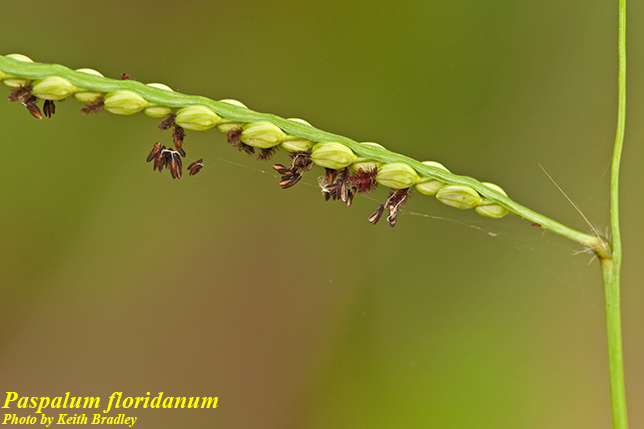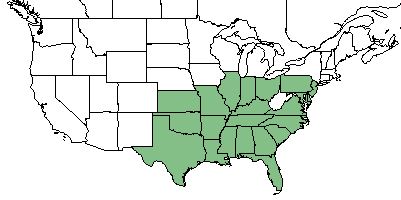Paspalum floridanum
Common name: Florida paspalum[1]
| Paspalum floridanum | |
|---|---|

| |
| Photo by Keith Bradley hosted at Atlas of Florida Plants | |
| Scientific classification | |
| Kingdom: | Plantae |
| Division: | Magnoliophyta - Flowering plants |
| Class: | Liliopsida - Moncots |
| Order: | Poales |
| Family: | Poaceae |
| Genus: | Paspalum |
| Species: | P. floridianum |
| Binomial name | |
| Paspalum floridanum Michx. | |

| |
| Natural range of Paspalum floridanum from USDA NRCS Plants Database. | |
Contents
Taxonomic Notes
Synonyms: P. difforme Le Conte; P. giganteum Baldwin ex Vasey.[2]
Varieties: none.[2]
Description
P. floridanum is a coarse, perennial graminoid of the Poaceae family native to North America.[1] It grows from a stout rhizome. The culms are 5-15 dm tall with glabrous nodes and internodes. The ligules are membranous and 1-2 mm long, while the 2-7 racemes are racemous, ascending, and 3-13 cm long. The spikelets are suborbicular, ellipsoid, 3-4 mm long, and grow in 4 rows.[3]
Distribution
P. floridanum ranges from New Jersey, Illinois, and Kansas, south to Florida and eastern Texas.[2]
Ecology
Habitat
P. floridanum proliferates in wet forests and pine savannas.[4] Specimens have been collected from disturbed roadside in pine-oak woodland, wet pine flatwoods and cypress depression, disturbed sandy field, longleaf pine stand, willow thicket, wiregrass savanna, pond-margin, marsh bank, mesic hammock, hardwood swamp, and sandy loam of hillside seepage.[5]
Phenology
P. floridanum flowers from August through October.[2]
Seed dispersal
This species is thought to be dispersed by gravity.[6]
Conservation and Management
P. floridanum is listed as extirpated by the Pennsylvania Department of Conservation and Natural Resources.[1]
Cultivation and restoration
Photo Gallery
References and notes
- ↑ 1.0 1.1 1.2 USDA Plant Database https://plants.usda.gov/core/profile?symbol=PAFL4
- ↑ 2.0 2.1 2.2 2.3 Weakley, A.S. 2015. Flora of the southern and mid-atlantic states. Working Draft of 21 May 2015. University of North Carolina at Chapel Hill, Chapel Hill, North Carolina.
- ↑ Radford, A. E., Ahles, H. E., & Bell, C. R. (1968). Manual of the vascular flora of the Carolinas. Chapel Hill: University of North Carolina Press.
- ↑ Weakley, A. S. (2015). Flora of the Southern and Mid-Atlantic States. Chapel Hill, NC, University of North Carolina Herbarium.
- ↑ URL: http://herbarium.bio.fsu.edu. Last accessed: June 2018. Collectors: Loran C. Anderson, Cecil Slaughter, R.K. Godfrey, J.R> Burkhalter, D.W. Hall, R.A. Pursell, R.Kral, N.C. Henderson, Paul Redfearn, A.H. Curtiss, William Reese, Jean Wooten, A.F. Clewell, Gary Knight, David Hall, Dan Skean, F.C. Craighead, Ann Johnson, R. Komarek, R.A> Norris, J.S. McCorkle, Wilson Baker, T. MacClendon, Annie Achmidt, William Platt, John Nelson, Wade Biltoft. States and counties: Florida (Wakulla, Nassau, Flagler, Jefferson, Escambia, Leon, Gulf, Dixie, Volusia, Okaloosa, Walton, Jackson, Gadsden, Flageler, Holmes, Duval, Levy, Osceola, Calhoun) Georgia (Thomas, Grady) South Carolina (Berkeley)
- ↑ Kirkman, L. Katherine. Unpublished database of seed dispersal mode of plants found in Coastal Plain longleaf pine-grasslands of the Jones Ecological Research Center, Georgia.